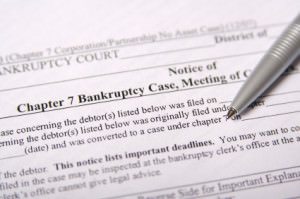When you find yourself completely overwhelmed by debts, bankruptcy is often your last resort. In the United States, Chapter 7 is the most common form of bankruptcy that people in your position file for. (The other common form for individuals, Chapter 13 , is a debt reorganization option.) Although a Chapter 7 bankruptcy filing can offer you considerable financial relief, you have to exercise some care if you want to file for it properly. This article can help you learn more.
How To Filing For Chapter 7 Bankruptcy
 The most basic requirement for filing Chapter 7 is simple residency. You have to live in the United States or at least own property in the country. Because it is the broadest form of bankruptcy available to US citizens, the requirements are minimal. This has changed in recent years, though. Chapter 7 bankruptcy was seriously affected by the Bankruptcy Abuse Prevention and Consumer Protection Act (BAPCPA) enacted in 2005.
The most basic requirement for filing Chapter 7 is simple residency. You have to live in the United States or at least own property in the country. Because it is the broadest form of bankruptcy available to US citizens, the requirements are minimal. This has changed in recent years, though. Chapter 7 bankruptcy was seriously affected by the Bankruptcy Abuse Prevention and Consumer Protection Act (BAPCPA) enacted in 2005.
BAPCPA added a few requirements to the Chapter 7 bankruptcy process. The earliest of these requirements that you’ll encounter are the new provisions that require you to seek assistance with your debts before filing. You’ll need to consult with an approved credit counselor and take a personal finance class. This is not simply a formality; the counseling you receive may well provide you with alternatives to filing. It is also in your best interests to get this counseling because failing to do so can be used as grounds for a bankruptcy court to deny your debt discharge.
The biggest change that the 2005 laws brought to Chapter 7 is the means test. This is a basic analysis of your current and projected future income. You will be subject to the means test if your income is above your state’s median income level. Typically, your monthly income is compared to both an absolute lower limit and your overall level of debt. If you do not meet the bankruptcy means test, it is still possible to file, but you will require a special circumstances exemption.
The actual process of filing can be handled in several different ways. The traditional method is using the services of a bankruptcy attorney. This is an option that you should strongly consider, even though it can be expensive. An attorney who specializes in bankruptcy work will be able to guide you expertly through the means test, the filing paperwork, and all subsequent legal action. If you want to save money, though, bankruptcy filings can also be handled by a trained paralegal. You can even file for bankruptcy on your own, although this requires careful study in order to ensure that all of the paperwork gets filled out correctly.
If you file successfully for Chapter 7 bankruptcy, you need to be aware that most of your assets will be liquidated in order to service your debts. The 2005 reforms made Chapter 7 much more strict about how much personal property you can protect from liquidation. Additionally, be prepared for the fact that certain types of debt (including child support and student loan payments) cannot be discharged when you file for bankruptcy.
This information should give you a better idea about the limitations and requirements you’ll face if you decide that Chapter 7 bankruptcy is the solution to your financial problems. Before you proceed with a filing, you’ll need to build up a much more detailed picture of the process, so keep making use of the bankruptcy education resources you find online.
